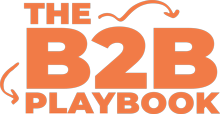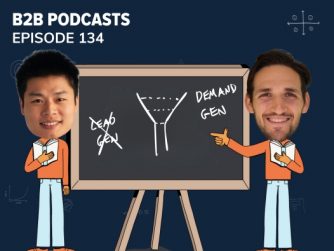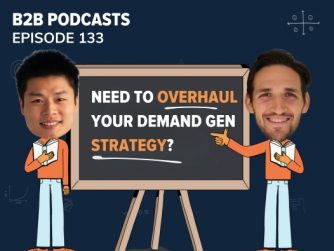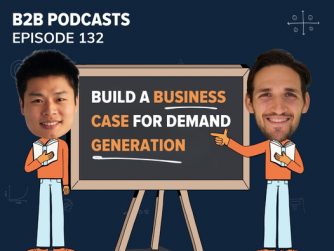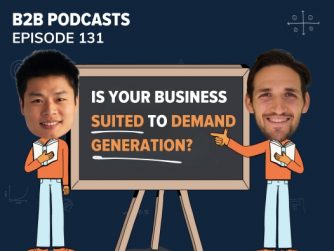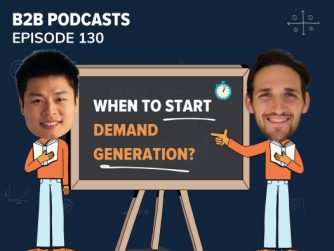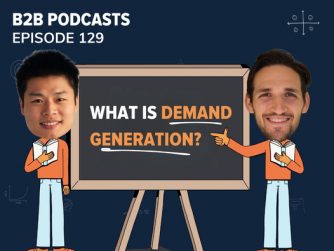Retaining an existing customer is cheaper…
That’s the common saying, and it’s certainly true.
We’re going to run you through how to make that the case by working on deal expansion and retention.
We’ll talk about specific examples of how to do this and ways to measure the success of your efforts.
Watch The Episode
Links Mentioned:
Harvard Business Review Article RE Retention
Ep 72 – Previous Measurement Episode
Article on customer retention formula
Sign up to our newsletter for the latest news and summary of the best content.
If you enjoy the podcast. Would you kindly consider leaving a short review? It takes only a minute and helps make a big difference in getting those amazing guests! We also love getting your insights by reading the reviews!
Transcript
Kevin Chen: Hi George. Be better Is all about optimizing your B2B marketing workflow. Now that we have all the fundamentals in place in the first three Bs, that’s deeply understanding your customers and be ready creating content that’s helpful to them and be helpful in order to build those relationships of trust online and be seen where we showed you how to amplify your helpful content to the right people and therefore accelerate your growth.
We’re now talking about how to optimize all that and your general B2B marketing workflows. And today, as George said, we’re talking about deal renewals and expansions, and also a little bit about retention, which is very much followed into that same process. Now, as George said, it’s something that we don’t talk about enough particularly in the marketing space.
In the marketing angle. Often it’s left to sales, to customer success. You might even have a retention team. But as we mentioned in previous episodes, those teams need to be very much extensions or collaborators or the main [00:02:00] collaborators of your marketing team, and you need to work together on all things that are to do with the growth of your business.
George Coudounaris: That’s it, Kev, whether there it’s sales or customer success, as you said, it’s a vital part of the business and we’ve gotta help them with it. So listeners today, We’re gonna talk you through first why customer retention and expansion is so important to the business. Then we’re gonna look at how you marketers can actually do it.
So Kevin and I are gonna give you some hot tips there, and then finally how to go about measuring the success of your retention and expansion programs. Alright, Kev, the context around this conversation. First, why is customer retention and expansion so important?
Kevin Chen: Well, George, it’s the old saying, right? Everyone says it in the marketing space, retention is so much more cost effective. There’s always those stats around how it’s 10 times, five times, 10 times, 20 times cheaper to retain a customer to retain an existing client and keep that existing client rather than bringing a new one [00:03:00] in.
And we will link to this article but there’s definitely a Harvard Business Review article on this where they’ve. Made that number at five to 25 times. So that’s five to 20 times more expensive to get a new customer than retaining an existing one. So there you go. Harvard Business Review should be accurate.
And. As George mentioned before, customer expansion is also low-hanging fruit. They’re your existing customers that you’ve already spent time and money to win over. They’re in your network. They’ve been in contact with you, easy to reach, and they bought into your products and services at some point.
And hopefully they still are. And clearly have a need for it. So that’s why they continue to be your client or customer. So let’s see if we can add some more value to them, to their business but at the same time increasing the revenue that we’re getting from them.
George Coudounaris: And Kev adding more value to our customers. I kind of plays into the next reason why this is so important for marketers to focus on is the more [00:04:00] value that you’re adding to your customers, the more chance there is that you’re gonna create raving fans and get customer referrals. Now, raving fans are those super happy customers that go around and tell everyone how incredibly brilliant you are. That is the holy grail for all marketer is to create a group of raving fans. Because Kevin, at the end of the day, word of mouth is still probably the most cost effective, most channel for acquiring new customers.
Kevin Chen: I couldn’t agree with you more, George and listeners, if you think about it. Word of mouth. It’s obviously something that attaches a lot of trust online, so it’s seen as more independent. It’s seen as someone who is very relatable to a potential client’s business. And so the reason why that becomes the best form of advertising is because you tend to trust that more, and as we said how five Bs is all about building trust online. And this is one of the best ways to.
George Coudounaris: and Kev, when it comes to expansion, already [00:05:00] touched on it, but if you have an existing customer, you really have a market that’s ready for any new products or services that you can offer them. So you’ve proven that value to a customer already. And once you’ve done that, Kev, we’ve got another stat here, I’ve gotta check it and find where it’s from.
It might have been from the same Harvard Review site, but. Apparently when you’ve proven value to a customer, they’re gonna be six times more likely to try a new product or service from your brand when it becomes available. So that gives your company wiggle room to develop new products or different messages or other branding initiatives, and all of a sudden we’ve got a good group of customers to then push that towards and test and see how that goes with.
Kevin Chen: That’s very important for your ongoing business growth, George. As you bring out those new products and services it’s often a struggle to get people on board to try those new things. But if you have diehard customers, if you. True fans of your [00:06:00] business, they’re really gonna be at the forefront of testing that with very little effort from you, which will really save you a lot in the long term.
So it’s not just about expansion and retention. Those retained customers also add a lot of value, not just to the bottom line now, but into the future.
George Coudounaris: And Kev expansion doesn’t just have to be about selling different products or services to the same customer. It can be, especially for many enterprise clients, Kev, it can be about selling more of an existing product or service to a current customer. example is, let’s say you run. An ed tech platform that helps students learn better. You sell that into schools and you sell it into them department by department. So maybe the strongest use case initially is the science department. So we’ve sold our platform into them. Once you get some great results there, some good case studies, that’s a perfect opportunity for deal expansion because there’s so many other departments that could use that exact same tech.
If they’re using more of your tech, that’s an opportunity for you to charge more. So [00:07:00] maybe the English and math department sign on.
Kevin Chen: And you can see listeners why it would be cheaper to do that deal with expansion. , maybe you can quantify at more than six times or whatever the stat is, the Harvard Business Review article says. But if you already have an in at a particular school, if you’re already talking to people that work there, it’s a lot easier to start a conversation and to build wider network within that business or school or whatever organization that might be.
If you already know someone there and you, a group of people there who can then validate what you’re saying internally as well.
George Coudounaris: And it’s easy care for the market to go already got that account customer success already have that relationship with them, or maybe the salesperson does, isn’t a one-to-one interaction with them just enough. Like why does marketing have to get involved here again, and Kev? I think it’s for that exact reason. Their interaction is generally one-to-one. It’s over the phone or it’s over the email. And yes, they might be their client. [00:08:00] That other person, that client, they have so many other things going on in their day. They don’t always want to hear about these new opportunities. Marketing weave, the ability to go one to fewer, one to many and target places and impose ourselves on them when they don’t necessarily wanna set the time aside to speak to us.
So we can absolutely give sales or custom success a hand here and start to educate them about these new opportunities.
Kevin Chen: Yeah. George in that sense, it’s just talking to new potential customers, right? Talking to existing customers. We can also warm up the rest of that business, the rest of that organization for your sales team, for your customer success team. Maybe they want to reach out to other departments, but if those other depart.
Are coming to us, knocking on the door to speak to us because they know a particular department already works with them and they can see a lot of advertisements or content or collaborations with us from other sources of information that they trust [00:09:00] online. Then doesn’t that solve a hard, with that potential cost or effort to bring in those even existing customer?
Different departments within those existing customers. So that’s really where we can start to help your customers success and your sales.
George Coudounaris: All right, so Kevin definitely sits within marketing’s remit, and we’re now moving on to listeners how you can go about doing this yourself and Kev. Our first point here is related to that. It’s about, first of all, Make sure you’re actually aligning with stakeholders and sales on the importance of customer retention and expansion. I know that we talk to so many of you listeners who are in tiny in-house marketing teams. You have limited time, you’ve got limited resources. So whenever you’re going after and doing something that’s outside of the normal expectation of your activities, it’s always best to align with stakeholders and get their it’s explain to them how marketing can help customer success, why there is such a great opportunity [00:10:00] for expansion and why it’s important to maintain this retention of your existing customers. So Kev, the first thing that I’d recommend that our listeners do is actually run an analysis of their customer churn. To identify the need for it. So it’s gotta start with the problem, right? Anytime you make a start with the problem. And that is, Hey look, based on this data, we do have some customer churn. For the expansion side of things, it comes down to, okay, you marketers have been handed a revenue target. Perhaps you could suggest that based on the data that you have, there’s actually a lot of opportunities within your existing customer set for expansion. There’s potential for more revenue from your existing customers, so if you need to hit those revenue targets, that’s a great way of doing it.
Kevin Chen: George, I think it’s important to call out to our listeners that in this initial first step of the process of doing deal expansion and retention support that. In [00:11:00] aligning with your stakeholders and sales and customer success, whatever that team might look like, it’s important to note. That process inherently means you’re then gonna be on the right track.
You might not know all the context around what you’re seeing in the data when you do that analysis of your customer churn or when you’re looking at opportunities for dealer expansion, it might look like everyone’s turning at a particular point in the life cycle or particular journey into your product.
But you might not have that context. So it comes back to the qualitative side of things. How is that feeling and the story for your quantitative data? And you’re gonna be able to get a lot of that from your extended team, from the sales team or customer success who are talking to your clients on a daily basis.
So they’ll really know the context around some of those points. You might see that particular page of the checkout process or the sign on process seems to be dropping a lot of Customers from, long-term retention or a particular [00:12:00] feature in the product is actually getting a lot of people to retain.
But sales and customer success might be able to put some context around why that is. So it’s really important when you’re doing that alignment process to actually go into it by thinking that, okay, the rest of the team is gonna be able to give me that qualitative insight, that qualitative data to fill in the blanks, to actually make sure that we’re focusing on the right opportunities and we have the right opportunities on the table for deal expansion or retention.
George Coudounaris: Such a good point. Kev, as we always say, quantitative tells you what happened, but qualitative tells you why. So often we marketers just sit behind our quantitative, we dig through our CRM and we go through our Google Analytics and we make up stories. we’ve just gotta get off our bums more and we’ve gotta go and talk to our team to find out that qualitative, find out the why.
All right, Kev. The next step, after aligning with stakeholders and going out and chatting to them, running that analysis of that customer churn and [00:13:00] identifying opportunities for expansion is to do your 80 20 to identify the top opportunities for expansion. Just really quickly, listeners, we’ve spoken about it before, but 80 20 is basically the principle that 20% of the input is driving 80% of the output. It’s really a way of saying, go and find your absolute best customers. And they’re the ones who are probably paying you the most amount possible for your services or using the most of your product and getting the most out of it. So if, for example, Kev, if you were HubSpot, your best customers would be the ones who are on your absolute top tier.
If your HubSpot and you’re looking at maybe the smaller business end, they’ve got a free tier, they’ve got a starter tier, and then they’ve got a professional. Um, Let’s say that they’ve identified their best customers as the ones who are on the professional tier, and they want to get a whole lot of their starter tier up to the professional tier.
So you pay 67 a month for a starter tier, [00:14:00] 1150 a month for a professional tier. We want to move more from the starter to the professional because they’re buying more of our products and paying more for it. Great opportunity for expansion, Kev. So I would start by first just running a report of the companies in the professional tier. Once I do that, Kev, I wanna look at. is it about these companies that means they’re getting so much out of the professional tier? So we start to look for commonalities in the type of companies they are and the type of people in those companies that are actually using the product. Kev, we spoken about this before, but it’s about analyzing those companies and trying to list out the demographic, the firmographic, and the psychographic qualities of these companies to show what makes them such a great. So demographic, Kev is things like uh, geography. Firmagraphic is the size of the company, the industry that it’s in. The different people who are using the product as well. You can define their roles then psychographic qualities too, Kev. So we wanna really list those out [00:15:00] and then see where the overlap is, and so then we can start to create again, an ideal customer profile of our best customer. Once we have that ideal customer profile, that group that are paying for the professional tier of HubSpot, if we were hubs. want to see what other companies look like this, but aren’t on that professional tier, so they’re not buying as much from us as they could. They’re on the start of tier and Kev, these are our target customers.
They’re the ones that we’re gonna try and get them to buy more.
Kevin Chen: It’s a great approach, George. And listeners if it sounds all a little familiar, it probably because it is it’s effectively the process you would go through to get new potential customers that are in the same profile as your existing best customers. But instead of doing that, we’re focusing that analysis on what’s the difference between your best customers and those.
They are already your customers, but you’re trying to be, make them your best customer group as well. So what you’re trying to bring [00:16:00] in effectively is your existing customers to a higher tier or a higher engagement rate with your business, and you’re looking for more specific differences between those two sets of businesses or clients.
George Coudounaris: You’re right Kev, this basically is the same process, isn’t it? but look, there’s a reason that we go through it again, it’s because it works. So we’ve started with that 80 20 analysis. We’ve identified those best customers, we’ve identified the group who we want to move into that higher paying group of customers. The next step for expansion is, I would say is the same with our other process is customer interviews. So we wanna interview those customers who are already getting the most out of your product. So we want to interview those who are on that professional tier because the key is we wanna find out why they’re buying those extra products and services from you, so when we interview them, we need to find out things like how does this help them with their jobs to be done? Um, [00:17:00] When it comes to HubSpot Kev, the difference between the professional tier and the starter tier is they give you things like social media automation, custom reporting have teams access to the platform, you get omnichannel reporting, you get campaign reporting.
So there’s a whole extra list of features there that you get access to. And the key is to find out which of those are the most important to those group of users in the professional tier, because they’re the ones that we really want to high. When we go back and show them to the style of tier, when we try and move them up. You also wanna find out, Kev, in those customer interviews, would they actually do if these extra products or services didn’t exist? So are they using an alternative? Is it just not a problem that’s big enough for them right now? You need to find that out. And then finally, Kev, you wanna find out what impact has it had on the business to. Have access to these new paid features. So what is the benefit of these extra services or products? It is that [00:18:00] you have sold them.
Kevin Chen: And just to re reiterate what George said earlier, the key here is to find out why they’re buying these extra products or services from you. What’s the difference between this group of customers and those that haven’t gotten to the same level?
George for retention, it’s much the same. We still then go on to customer interviews, but in this case, we also focus in on churned customers. We try and get into contact with them and talk about why they churned. Was it a lack of support? Was that, that they didn’t know how to get enough use out of the tools that we’re offering, or potentially there should be improvements to tools to make them more useful.
And what did they switch to? What was the alternative they looked at and then switched to and why? So all these different points that then give you an understanding of what the difference is and find out that key. Difference between those customers that churn and those that retain in the platform so that you can work to improve and reduce those churn points and improve the product itself.[00:19:00]
George Coudounaris: And again, Kev, this is all amazing qualitative information that you’re just not gonna get from the quantitative side. You might be able to jump into the platform and do some analysis to see where people perhaps drop off in your platform, but it’s never gonna tell you why. So you’ve gotta go and interview those best customers and those churning customers to find out that information.
Kev, the next step after customer interviews is really start to gear up and prepare yourself by creating collaborative content with those existing best customers that use your products and services.
And we’re gonna arm ourselves with a whole lot of social proof. We’re gonna build case studies. We’re going to highlight the pain points that they were suffering from and the benefits that they’ve got by buying more of our product and. Because Kev, we wanna have all this awesome, helpful information to show to those customers we would like to[00:20:00] buy more of our stuff, so social proof, case studies, Kev particular features and the particular benefits that they got from those features, they’re absolutely vital in teasing out.
Kevin Chen: and then there’s a process of distributing that content, that stuff that you’ve geared yourself up with in front of potential accounts that you are trying to move through a deal expansion process or to retain. So you can do this in a few ways. You can do it one-to-one, one to few, or one to many as George mentioned before.
Some examples of different ways to do this is one to many. You can look at doing organic social or paid social or even email marketing and really focus in on targeting those customers where you can. Who are in that category of already in your existing group, but aren’t really your best customers or aren’t really on the tiers that you want them to be on, and maybe in an email marketing series, you can show customers how to get the most out of your product to get them to the [00:21:00] next tier and make sure you target that again to that group of customers who are in the tier that you want to really target and move to the next tier with.
A few examples could be specific webinars or workshops for existing customers that you are hosting. So they’ve shown an interest that then come into a more intimate setting where you have a bit more time to engage with them and show them the benefits and features that they could be using.
And then one-to-one could be things like, Podcast interview. So you invite particular clients onto your podcast, onto doing joint research projects or inviting them to host an event with you and using that opportunity to get more FaceTime and to get them to, I guess indirectly connect with your brand again and understand what’s involved in your brand, in your products that can actually service them and may be able to have those light bulb moments in those interactions.
Some of this one-on-one work can also be passed on [00:22:00] through collateral to your sales and customer success teams so they can take the leading role in those conversations with those potential customers that could be moving from one tier to the next.
They can take the collateral that you’ve put together, that you’ve gone through this research process with them and with your best customers with. And based on that, they can then have strong backing to take into those conversations to help with the deal expansion process.
George Coudounaris: there’s so many different ways there, Kev, that marketing can help distribute vital information when it comes to trying to get that expansion. Sales and customer success can’t do so much of that without you. So it’s very clear why marketing need to be involved in this process.
You guys are the absolute experts when it comes to this. This really isn’t within their wheelhouse. So particularly when it comes to the one to many and one to few distribution, you guys need to be there. And even Kev when it comes to trying to figure out the angle, the positioning of. [00:23:00] New product that you’re selling or new problem as well because you’ve gotta position it in a way that really deeply resonates with that customer, that target customer that you’re going after. And again, Keva, I would argue that that is marketing’s function.
Kevin Chen: Last note for you listeners on how to execute. Remember to keep in mind that when you’re distributing these things, you don’t have to come up with all these ideas yourself. You can have a look around your industry and see what the best players are doing in this space and see if anything is applicable to yourself.
But we would recommend you actually focus in on what has your dream customers. What has your best customers told you about how they like to hear about new products and services? What have they told you about how other departments work in their business? And see if you can tap into those channels that they’re already telling you they exist in, they trust and they play in online.
And it’s just like the same process that we’ve done before where we look at the channels and we decide which channels to go for [00:24:00] when we’re trying to bring in potential new customers. With existing customers, it’s exactly the same. Ask them directly where they want to hear more from us.
George Coudounaris: Very good, Kevin. All right. Measurement. Kev, when it comes to the measurement piece It’s actually pretty similar to the measurement episode that we’ve gone through. Previously, and Kev, we’ll get you to link to that in the show notes. So really there’s the three tiers of reporting and measuring when it comes to deal expansion. first looking at the channel level KPIs to indicate that you’re getting the right engagement from those target accounts, where wherever it is that you’re distributing. helpful information about that new product or service. The second tier is qualitative and quantitative feedback that show positive or negative signals about how they’re actually responding to it. Are we getting those target accounts to check out our sales collateral? Are they coming to our website and reading information about these new products? Are they engaging with us more or not? Are [00:25:00] we starting to get more sales qualified opportunities and care if that comes. Final point of measurement is are we actually generating any more opportunities for the customer success team to expand those deals with those target accounts? And that’s ultimately what we wanna measure, right? Is we wanna look in our CRM at the end of the day and we wanna see those opportunities open and we wanna see that we’ve had a hand in that.
Kevin Chen: Now listeners for customer retention you probably just wanna look at customer retention rate. That’s the most basic one to look at, to measure that. Learning to calculate customer retention is pretty easy once you know the formula. So that’s basically just customer retention rate equals the number of customers at the end of a given period minus the number of new customers that have come in. And then you can basically just divide that by the number of customers at the beginning of that time period.
I guess just like last episode when we went through a similar formula, it never really works that well in a podcast format, so we [00:26:00] probably will have to do an article on this and explain that in more detail on paper and in writing.
But really looks a bit more complicated than it really is. It’s pretty simple. If you. Google how to create your customer retention rate. Online, you’ll be able to find pretty easy ways to do it. We won’t go into too much detail about it, but that’s obviously the most basic one to look at there.
And you’re really just measuring, how many customers are you losing over time? How many are you keeping over time? And how can we increase the number that you’re retaining over time?
George Coudounaris: And Kev, there’s so many more metrics to look at when it comes to customer retention and also customer satisfaction. This episode, Kev, has probably been more focused on the deal expansion side of things. we might have to have a whole separate episode when it comes to retention. But yeah, customer retention rate is the basic one that you guys should definitely get started with. We’re not confuse anything anymore editing in more more jargon and more different [00:27:00] ways of measuring it.
Kevin Chen: I might just add one more, George
George Coudounaris: All right.
Kevin Chen: indirect, Indirect conflict to your last statement. But I think net promoter score is another one that people should have a look at. It’s not directly related to just retention or deal expansion, but net promoter score often comes up in the space and measure, product satisfaction, how much you’re likely to promote your product to somebody else, that sort of thing.
It’s all related in the same space, but as George said, focus on customer attention rate. Have in mind that Net Promoter score might come into it and we’ll talk about it all in another episode.
George Coudounaris: That’s it. Kev, there’s a lot to talk about when it comes things like net promoter score. But also to be weary of just survey slapping people with gather net promoter scores. They are those substitute for sitting down with your customers and actually talking to.
Kevin Chen: yeah. Probably more warning than than something to look at.
Well Listeners, key [00:28:00] takeaways for this episode. Deal expansion and retention are lower hanging fruit for marketers to help meet revenue goals. Yes, it is the role of marketers to help.
Customers that buy more of your products and services and stick with you are more likely to turn into raving fans and raving fans drive word of mouth and is key to building sustainable growth engine in the long term.
And make sure to measure your expansion and retention efforts to justify the time and money spent on it in a business.
George Coudounaris: Very good, Kevin. Thank you. As always, you can find links to everything that Kevin and I discussed in the show notes, and we’re so grateful that each week, more and more marketers are tuning in every Monday morning to the B2B Playbook podcast. And if we can ask one thing, it would be to please leave us a short review on whatever platform it is you listen on, or pass it on to someone who you think would get huge value from the show.
It’s a huge help to us, and we really, really appreciate it. Kevin, thank you so much for your time. Great to see you again. I’m glad you’re [00:29:00] enjoying London. Take care. Catch you next week listeners.
Kevin Chen: Ah. Thanks, George. Thank you, listeners. See you next week.
